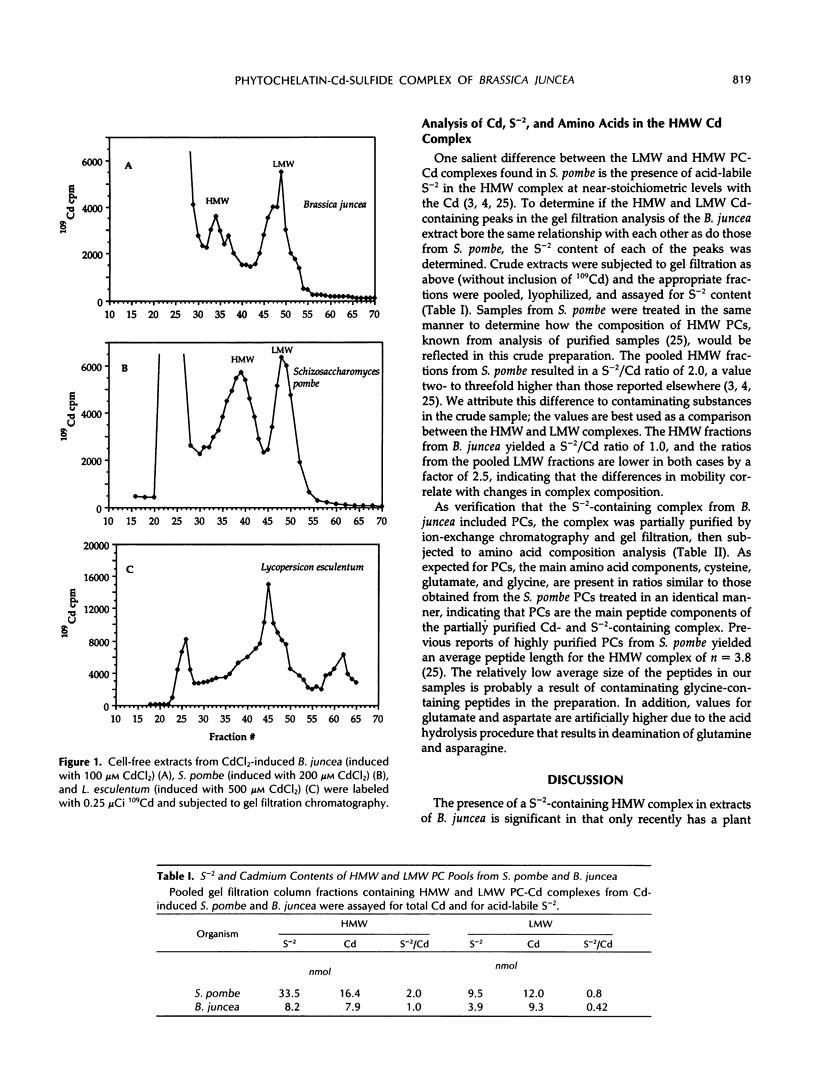Abstract
Phytochelatins (PCs) are enzymically synthesized peptides produced in higher plants and some fungi upon exposure to heavy metals. We have examined PC production in the Se-tolerant wild mustard Brassica juncea and found that it produces two types of PC-Cd complexes with the same characteristics as those from fission yeast Schizosaccharomyces pombe, including a high molecular weight PC-Cd-sulfide form.
Full text
PDF




Selected References
These references are in PubMed. This may not be the complete list of references from this article.
- Abrahamson S. L., Speiser D. M., Ow D. W. A gel electrophoresis assay for phytochelatins. Anal Biochem. 1992 Feb 1;200(2):239–243. doi: 10.1016/0003-2697(92)90459-k. [DOI] [PubMed] [Google Scholar]
- Dameron C. T., Smith B. R., Winge D. R. Glutathione-coated cadmium-sulfide crystallites in Candida glabrata. J Biol Chem. 1989 Oct 15;264(29):17355–17360. [PubMed] [Google Scholar]
- Fett W. F., Dunn M. F. Exopolysaccharides Produced by Phytopathogenic Pseudomonas syringae Pathovars in Infected Leaves of Susceptible Hosts. Plant Physiol. 1989 Jan;89(1):5–9. doi: 10.1104/pp.89.1.5. [DOI] [PMC free article] [PubMed] [Google Scholar]
- Grill E., Löffler S., Winnacker E. L., Zenk M. H. Phytochelatins, the heavy-metal-binding peptides of plants, are synthesized from glutathione by a specific gamma-glutamylcysteine dipeptidyl transpeptidase (phytochelatin synthase). Proc Natl Acad Sci U S A. 1989 Sep;86(18):6838–6842. doi: 10.1073/pnas.86.18.6838. [DOI] [PMC free article] [PubMed] [Google Scholar]
- Grill E., Winnacker E. L., Zenk M. H. Phytochelatins, a class of heavy-metal-binding peptides from plants, are functionally analogous to metallothioneins. Proc Natl Acad Sci U S A. 1987 Jan;84(2):439–443. doi: 10.1073/pnas.84.2.439. [DOI] [PMC free article] [PubMed] [Google Scholar]
- Grill E., Winnacker E. L., Zenk M. H. Phytochelatins: the principal heavy-metal complexing peptides of higher plants. Science. 1985 Nov 8;230(4726):674–676. doi: 10.1126/science.230.4726.674. [DOI] [PubMed] [Google Scholar]
- Hamer D. H. Metallothionein. Annu Rev Biochem. 1986;55:913–951. doi: 10.1146/annurev.bi.55.070186.004405. [DOI] [PubMed] [Google Scholar]
- Jackson P. J., Unkefer C. J., Doolen J. A., Watt K., Robinson N. J. Poly(gamma-glutamylcysteinyl)glycine: its role in cadmium resistance in plant cells. Proc Natl Acad Sci U S A. 1987 Oct;84(19):6619–6623. doi: 10.1073/pnas.84.19.6619. [DOI] [PMC free article] [PubMed] [Google Scholar]
- Karin M. Metallothioneins: proteins in search of function. Cell. 1985 May;41(1):9–10. doi: 10.1016/0092-8674(85)90051-0. [DOI] [PubMed] [Google Scholar]
- Mehra R. K., Garey J. R., Butt T. R., Gray W. R., Winge D. R. Candida glabrata metallothioneins. Cloning and sequence of the genes and characterization of proteins. J Biol Chem. 1989 Nov 25;264(33):19747–19753. [PubMed] [Google Scholar]
- Mehra R. K., Tarbet E. B., Gray W. R., Winge D. R. Metal-specific synthesis of two metallothioneins and gamma-glutamyl peptides in Candida glabrata. Proc Natl Acad Sci U S A. 1988 Dec;85(23):8815–8819. doi: 10.1073/pnas.85.23.8815. [DOI] [PMC free article] [PubMed] [Google Scholar]
- Murasugi A., Wada C., Hayashi Y. Cadmium-binding peptide induced in fission yeast, Schizosaccharomyces pombe. J Biochem. 1981 Nov;90(5):1561–1564. doi: 10.1093/oxfordjournals.jbchem.a133627. [DOI] [PubMed] [Google Scholar]
- Murasugi A., Wada C., Hayashi Y. Occurrence of acid-labile sulfide in cadmium-binding peptide 1 from fission yeast. J Biochem. 1983 Feb;93(2):661–664. doi: 10.1093/oxfordjournals.jbchem.a134222. [DOI] [PubMed] [Google Scholar]
- Murasugi A., Wada C., Hayashi Y. Purification and unique properties in UV and CD spectra of Cd-binding peptide 1 from Schizosaccharomyces pombe. Biochem Biophys Res Commun. 1981 Dec 15;103(3):1021–1028. doi: 10.1016/0006-291x(81)90911-6. [DOI] [PubMed] [Google Scholar]
- Mutoh N., Hayashi Y. Isolation of mutants of Schizosaccharomyces pombe unable to synthesize cadystin, small cadmium-binding peptides. Biochem Biophys Res Commun. 1988 Feb 29;151(1):32–39. doi: 10.1016/0006-291x(88)90555-4. [DOI] [PubMed] [Google Scholar]
- Rabinowitz J. C. Analysis of acid-labile sulfide and sulfhydryl groups. Methods Enzymol. 1978;53:275–277. doi: 10.1016/s0076-6879(78)53033-4. [DOI] [PubMed] [Google Scholar]
- Rauser W. E. Phytochelatins. Annu Rev Biochem. 1990;59:61–86. doi: 10.1146/annurev.bi.59.070190.000425. [DOI] [PubMed] [Google Scholar]
- Reese R. N., Mehra R. K., Tarbet E. B., Winge D. R. Studies on the gamma-glutamyl Cu-binding peptide from Schizosaccharomyces pombe. J Biol Chem. 1988 Mar 25;263(9):4186–4192. [PubMed] [Google Scholar]
- Reese R. N., White C. A., Winge D. R. Cadmium-Sulfide Crystallites in Cd-(gammaEC)(n)G Peptide Complexes from Tomato. Plant Physiol. 1992 Jan;98(1):225–229. doi: 10.1104/pp.98.1.225. [DOI] [PMC free article] [PubMed] [Google Scholar]
- Reese R. N., Winge D. R. Sulfide stabilization of the cadmium-gamma-glutamyl peptide complex of Schizosaccharomyces pombe. J Biol Chem. 1988 Sep 15;263(26):12832–12835. [PubMed] [Google Scholar]
- Scheller H. V., Huang B., Hatch E., Goldsbrough P. B. Phytochelatin synthesis and glutathione levels in response to heavy metals in tomato cells. Plant Physiol. 1987 Dec;85(4):1031–1035. doi: 10.1104/pp.85.4.1031. [DOI] [PMC free article] [PubMed] [Google Scholar]
- Steffens J. C., Hunt D. F., Williams B. G. Accumulation of non-protein metal-binding polypeptides (gamma-glutamyl-cysteinyl)n-glycine in selected cadmium-resistant tomato cells. J Biol Chem. 1986 Oct 25;261(30):13879–13882. [PubMed] [Google Scholar]


